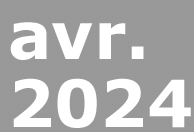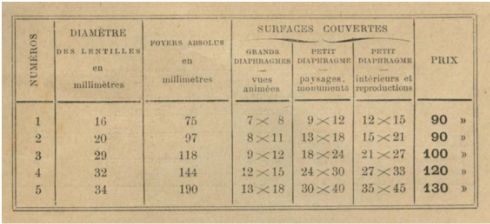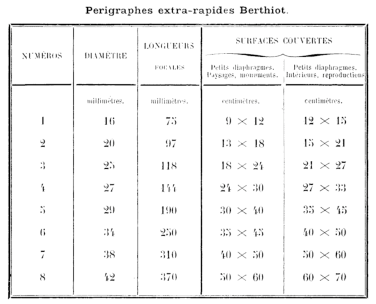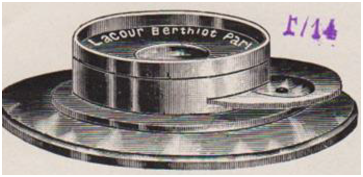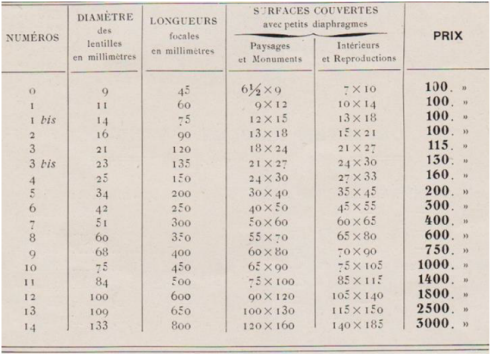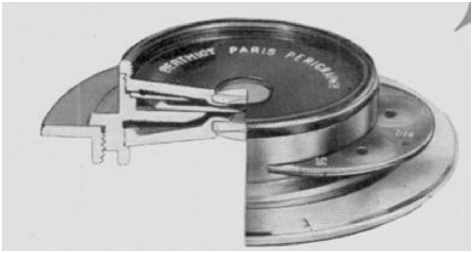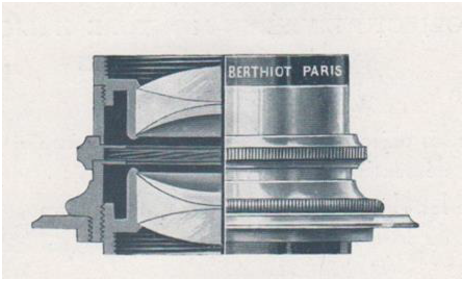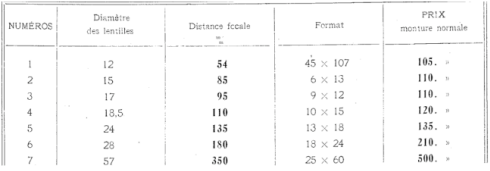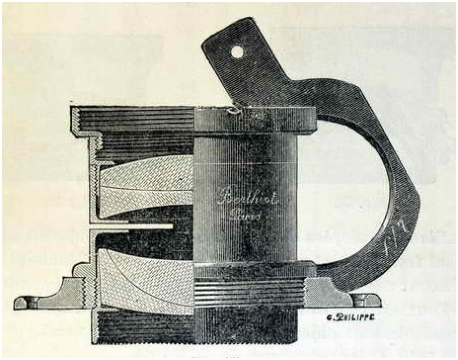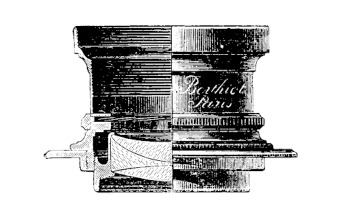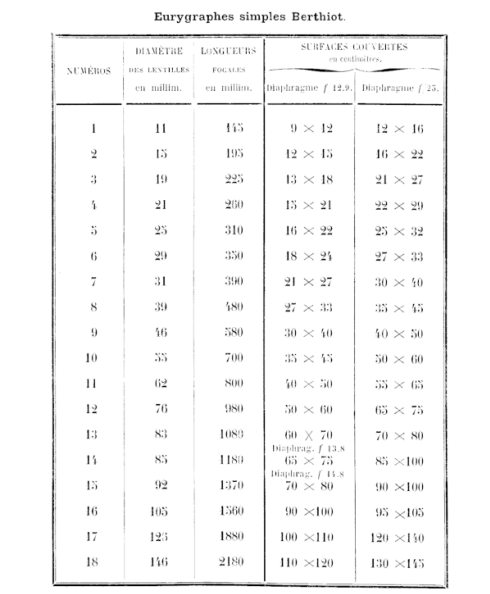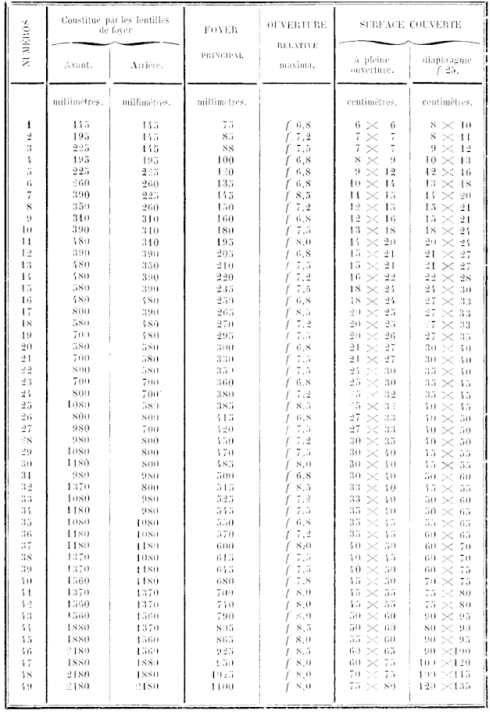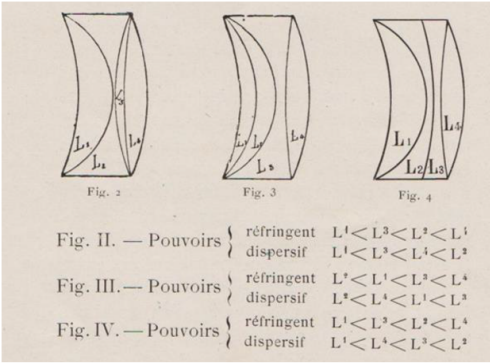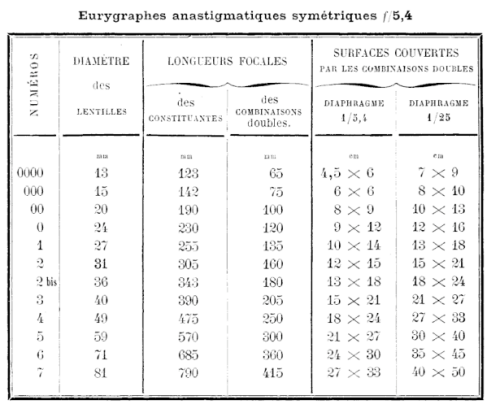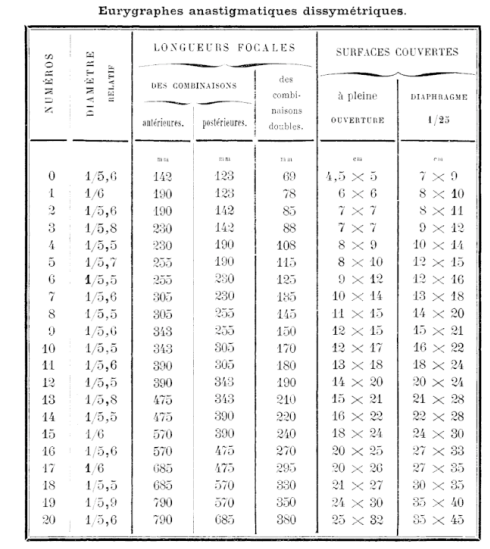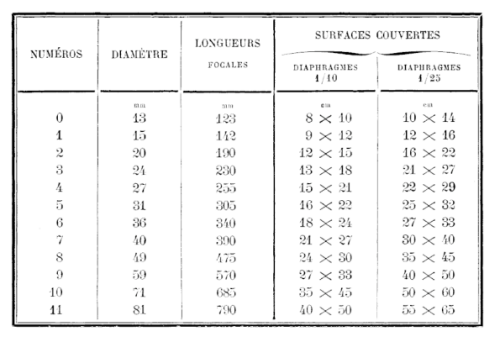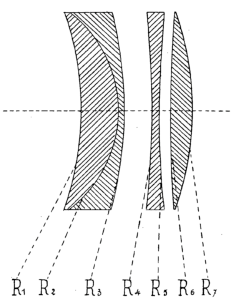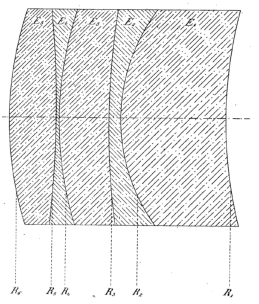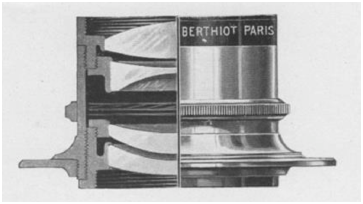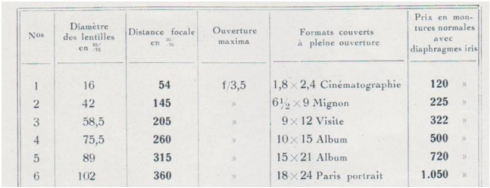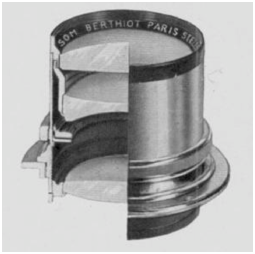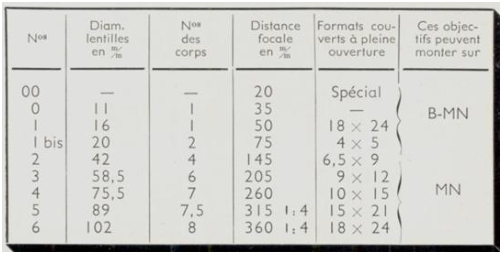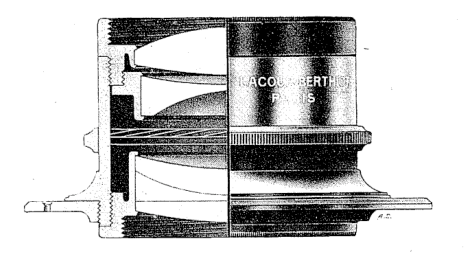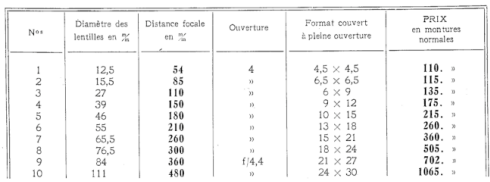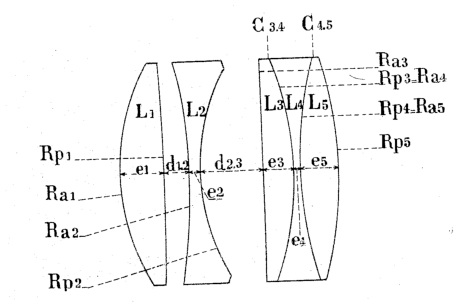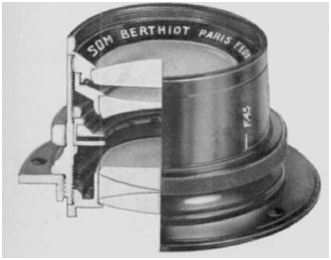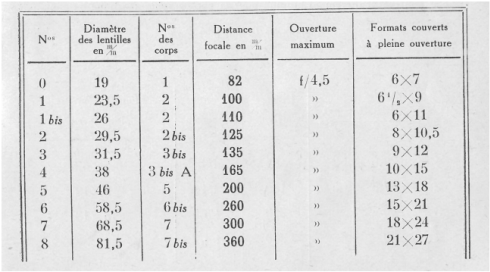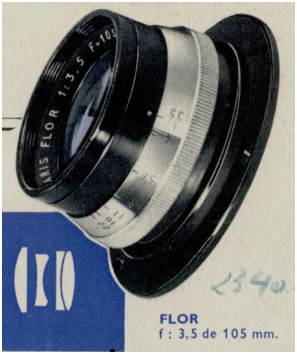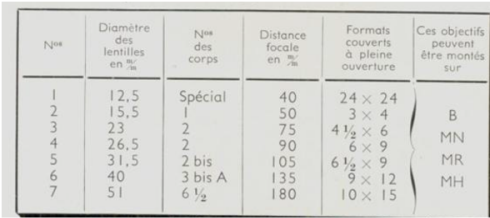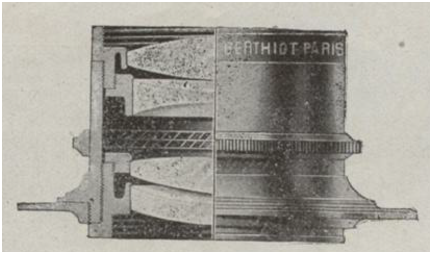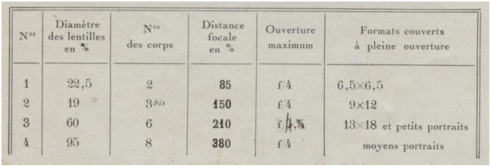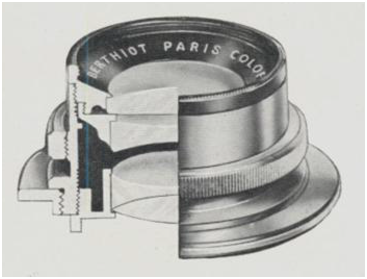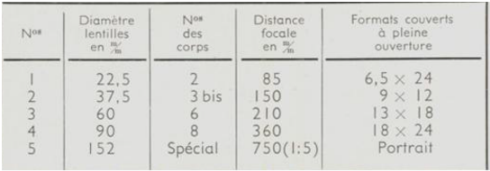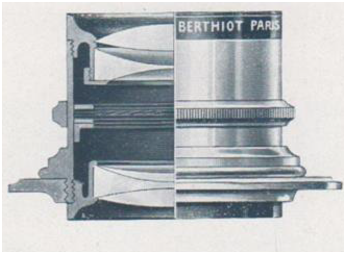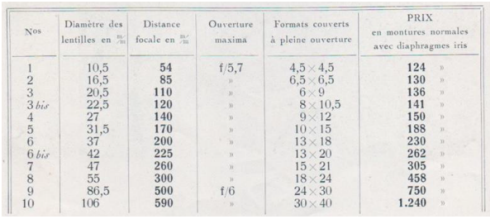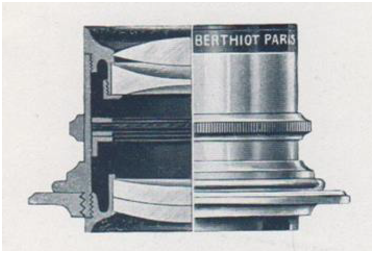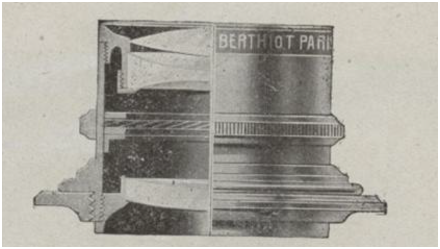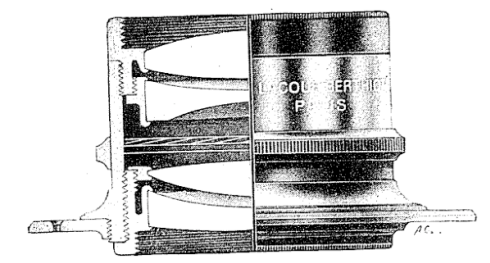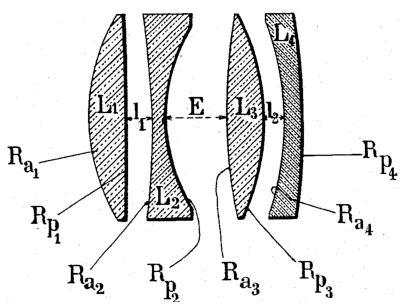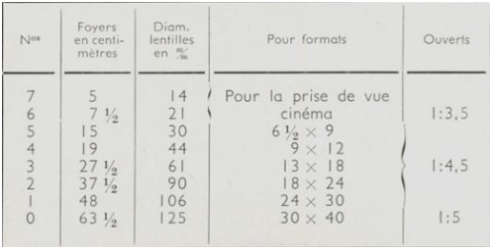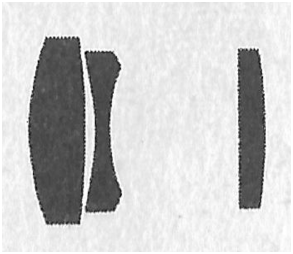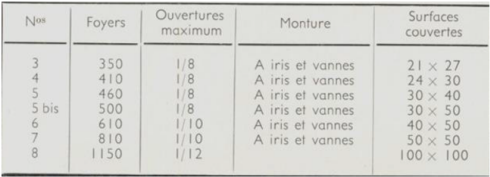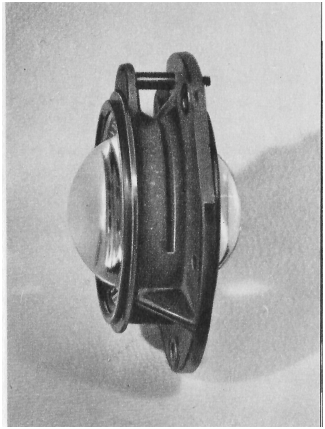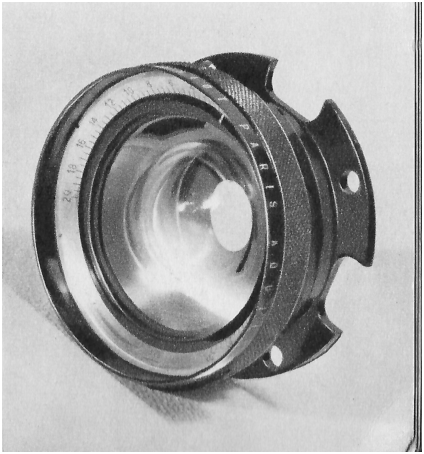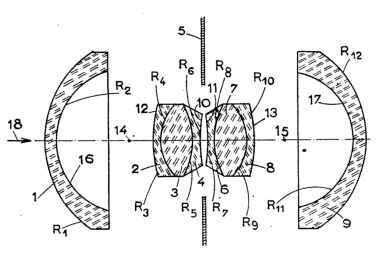|
|
||||||||||||||||||||||||||||||||||||||||||||||||||||||||||||||||||||||||||||||||||||||||||||||||||||||||||||||||||||||||||||||||||||||||||||||||||||||||||||||||||||||||||||||||||||||||||||||||||||||||||||||||||||||||||||||||||||||||||||||||||||||||||||
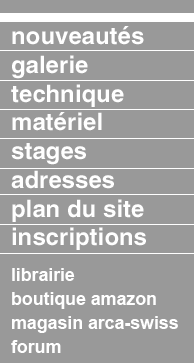
the author
Translation by
|
Berthiot’s large format anastigmatspar Daniel W. Fromm 1 IntroductionThe only work so far on Berthiot’s large format lenses is Pont and Princelle (2013). This lavishly illustrated booklet is essentially a list of lenses with little text. It is rare, with only 100 copies published, is inaccessible and has a few gaps and errors. As one volume of a larger set on French photographic objectives, 1839 – 1939, it reports on Berthiot lenses made no later than 1939. Since, however, Berthiot’s large format product slate was essentially frozen well before 1939 this ending date is insignificant. Catalogs from the early 1950s mention only three lens types not in pre-WW II catalogs. In spite of Pont and Princelle’s work and even though Berthiot was a, possibly the, major French lens maker, Berthiot’s large format lenses remain poorly known. In this article I present information on Berthiot large format anastigmats taken from Berthiot catalogs and, primarily for pre-1912 lenses, Charles Fabre’s monumental Traité encyclopédique de photographie and various issues of the Bulletin de la Société Française de Photographie (BSFP). 2 SourcesThe catalogs I used that can be dated are from 1889, no earlier than 1908 (possibly 1910), 1912, 1915, 1922, 1927, 1936, 1950 or so. I used others that couldn’t be dated more closely than the 1920s and late 1940s/early 1950s. The gap between 1889 and 1908 (possibly 1910) is a problem. Because of it I can’t determine when Berthiot began referring to their lenses by series, as in the 1908 (perhaps 1910) catalog. Fabre’s Traité encyclopédique de photographie was published in 8 volumes between 1889 and 1906. Volumes 5 (First Supplement A, 1892), 6 (Second Supplement B, 1897), 7 (Third Supplement C, 1902) and 8 (Fourth Supplement D, 1906) report on lenses introduced since the previous volume. Berthiot lenses are discussed in volumes 7 and 8 but are not identified by series. This suggests that Berthiot began designating lenses by series later than 1906. La Société Française de Photographie met monthly. Its Bulletin, which contains reports on the meetings and more, was issued as monthly numbers of annual volumes. New lenses were discussed at the meetings and lenses were advertised in the bulletin. Digitized volumes of the bulletin for 1855 – 1909, 1920 – 1924 are available on line. There’s very little on Berthiot lenses in the 1901-1909 volumes. I can only wonder about what was said in BFSP about new lenses in Berthiot’s 1912 catalog. I would like to have supplemented these sources with modern users’ reports from the Internet. Unfortunately, searches of the likely places (www.galerie-photo.com, www.galerie-photo.info, http://www.largeformatphotography.info/forum/, http://www.largeformatphotography.info/ and www.photrio.com) found many errors and little that was useful. 3 Brief corporate historyClaude Berthiot (1821 – 1896) began making photographic lenses in 1857. His nephew Eugène Lacour entered the business in 1884 and assumed control in 1894. From 1894 to 1908 the firm traded as Lacour-Berthiot. It was incorporated as Établissements Lacour Berthiot S.A. in 1908, with Lacour as general director and Charles Henri Florian as technical director. This history is from the 1908 (perhaps 1910) catalog. It operated under that name from 1908 to 1913, when it took the name La Société D’Optique et de Mécanique de Haute Precision (S.O.M). At that time the arms maker Schneider-Creusot provided a large injection of capital and took 50% of the firm’s shares. From then on it sold lenses engraved SOM Berthiot. In 1934 SOM acquired the venerable lens maker Hermagis. It eventually discontinued most Hermagis products but continued to produce and sell Hermagis’ T.P.H. process lenses and Eidoscope soft focus lenses. The firm sold SOM Berthiot lenses until the mid-1960s, when it was merged with Société Optique et Précision de Levallois, S.A. (OPL) to form SOPEM, later SOPELEM. SOM Berthiot seems to have stopped making lenses for large format photography in the early 1950s. It continued to make lenses for small and medium format still cameras and for cine cameras and projectors, also made lenses and optical goods for military applications. 4 Benoist BerthiotSearches for Berthiot on, e.g., ebay.fr, often turn up Benoist Berthiot lenses. They should not be confused with lenses made by Claude Berthiot and successors. Benoist Berthiot, now B.B.G.R. and a subsidiary of the eyeglass manufacturer Essilor, originated in 1836 as a glass works owned by Louis Berthiot. After Louis Berthiot took F. Benoist into partnership the firm operated as F. Benoist, L. Berthiot et Cie. In addition to glass, Benoist Berthiot made eyeglasses, projection lenses and a very few taking lenses. f/1.9 Oscillo-Star, for Ribet-Desjardins oscilloscope cameras, and a 40/2.8 for the Mecaflex SLR. Benoist Berthiot never had a connection with Claude Berthiot or his successors. 5 Berthiot lens designationsBerthiot initially designated lenses by name, e.g., Objectif Périgraphique. They started using series designations and subtypes sometime between 1906 and 1908 (or perhaps 1910). The 1908 (or perhaps 1910) catalog refers on p. 8 to “our former anastigmatic Eurygraphes, series I, II, III, and IV” and discusses the new ones as “series Ia, IIa, IIIa, and IVa” on pp. 8-9. However, it offers only Ib, IIb, IIIb, and IVb. I suspect a failure of proofreading. Eurygraphes with series numbers (II, IIa, III, IIIa) are, however, mentioned on pages 156 and 176 of the 25 July, 1908 issue of Photo-Gazette and are not mentioned at all in the two previous years. Series designations may, then have started in 1908. After 1908 (perhaps 1910) Berthiot referred to their lenses by trade name, e.g., Stellor, and series and subtype, e.g., Ser. Ia (f/3.5 Stellor) and Ser. Ib (f/4 Stellor). Assignment of trade name, series and subtype to a design type sometimes changed over time. Understanding exactly what an older Berthiot anastigmat is can be difficult. The problem is worst for lenses from the last extreme wde angle rectilinears (the Objectif Périgraphique of 1889 and Objectif Périgraphique Extra-Rapide of 1892, neither an anastigmat even though Pont and Princelle say they are) through around 1912. In 1912 old trade names and series designations were replaced by completely new ones, new classes of anastigmats (Tessar-like, triplets, etc.) were added to the product slate and some older designs were dropped. Some of the new trade names included several design types. After 1912 Berthiot’s product slate changed little. A few new trade names and design types were added, a few were dropped. The number of focal lengths offered fell over time. Series designations don’t appear in my post-WW II catalogs. 6 When did Berthiot stop making large format lenses?Patrice-Hervé Pont has published two Berthiot chronologies so far. The second, in Pont and Princelle , stops in 1939. The first, Pont (2000), goes through 1982/85. It reports that Berthiot initially numbered lenses sequentially. Old-style serial numbers carry no information about the dates they were assigned or used. Pont thinks that the last old-style s/n, 1,180,000 or so, was used in 1951. Starting in 1952 Berthiot lenses’ serial numbers were alphanumeric, with the first character a letter that corresponded to year. The last letter listed in Pont’s chronology was U, for 1982/85. I’ve watched Berthiot lenses offered for sale for years and haven’t yet seen a serial number on a Berthiot large format lens for civilian use that began with a letter. Cine lenses and lenses for small format cameras, yes, of course, but not large format lenses. Pont and Princelle report that many of Berthiot’s LF lenses were made into the 1960s. I disagree. That production ended in 1951 more is plausible. However, Berthiot continued to make process lenses that were not sold as LF taking lenses. 7 The lensesBerthiot’s first anastigmat was the Eurygraphe Extra Rapide of 1894, followed by a succession of Eurygraphes of different design types and the f/14 Périgraphe, an extreme wide angle version of the last Eurygraphe type. Eugène Lacour created all of them. Some of Lacour’s Eurygraphe variants offered in the 1908 catalog were discontinued by the time the 1912 catalog was published. Charles Henri Florian became Berthiot’s technical director in 1908. He introduced new design types in the 1912 (Graphor, Nébulor, Olor, Stellor) and 1922 (Flor, Orthor) catalogs. The Color, also introduced in 1922, was designed by Dr. Aron Polack. Berthiot’s next new large format lens designs, Apographe, Aquilor, and Orthor (undocumented and not the same as the 1922 Orthor) appeared after the end of the second world war. None was intended for general photography. Berthiot’s early anastigmats were engraved with trade name and “No,” short for number, but not with focal length. Catalogs had magic tables that translated trade name and No to focal length. Starting no later than around 1908 (perhaps 1910), Berthiot also engraved focal length on their lenses. I present magic tables as available. That few new lenses were introduced after 1912 gives the false impression that technical progress at SOM Berthiot stopped shortly before the first world war. However, by the time the 1936 catalog was published Berthiot had developed a full line of lenses for cine-cameras and projectors as well as lenses for 35 mm and roll film cameras. That’s where their efforts went and where they continued to progress. I believe that’s where the market opportunities were. In one respect, however, Berthiot showed extreme conservatism. Like many other early lens makers, Berthiot offered rapid rectilinear casket sets. After anastigmats replaced rectilinears, Berthiot offered casket sets that used Eurygraphe and, for a time, Périgraphe cells. Berthiot seems to have been the only maker offering casket sets after the late 1920s, continued with them until the early 1950s. 7.1 Berthiot-Lacour eraDuring this period – 1888 – roughly 1910 – Berthiot used variants of two trade names for their anastigmats: Périgraphe, which first appeared in 1888, and Eurygraphe, first offered in 1894. Claude Berthiot designed the first two Périgraphes, both wide angle rectilinears. His nephew and successor Eugène Lacour designed all of the anastigmats. Most, if not all, of their lenses were discussed extensively in the French photographic press. New developments driven, I think by a combination of competitive pressure and technical progress, especially in optical glass, are fairly, if sometimes confusingly, well documented. I present them in the order the trade names were introduced. 7.1.1 PérigraphesBerthiot’s first “Périgraphe,” a wide angle rectilinear, was introduced in 1888. The model name was applied to a succession of designs, all wide angle lenses, that culminated in the f/6.8 Ser. VIb of 1912. The first anastigmat in the line was the f/14 Périgraphe Anastigmatique of 1899. Berthiot made Périgraphes until they stopped making large format lenses in the early 1950s. Berthiot may not have been the first lens maker to use the trade name Perigraph or Perigraphic. Gundlach Optical Company of Rochester, New York made a Perigraphic Lens as early as 1888. It was a triple convertible rapid rectilinear whose cells were cemented aplanatic triplets. The earliest reference to it I’ve found is in The Industries of the City of Rochester, a directory published in 1888. Also see US Patent 442,251. Objectif Périgraphique (1888) This is a wide angle rectilinear lens with greater coverage than its predecessors. Like them it has four elements in two groups. I start with it because it is the first in a long line of “Périgraphes,” most of them anastigmats. Introduced in 1888. Fabre (1889, p.86) was quite taken with it: 60. M. Berthiot’s Perigraphic Objective. -- With the goal of making an extreme wide angle rectilinear lens, M. Berthiot recently modified his old lenses and established a new series of wide angle lenses. The tests we recently made on two lenses, focal lengths 97 and 118 mm, proved for us that these lenses give up nothing to the Pantoscope [Busch’ Pantoscop, another extreme wide angle lens] in coverage while giving us considerably more illumination, their widest aperture being f/15. This lens is invaluable for obtaining interior shots when there’s not enough space to step back. It covers the widest angle on 13 x 18 of all the lenses I’m acquainted with. Berthiot’s 1889 catalog lists five focal lengths (“Foyers absolus”):
Fabre (1897, p. 106-7) mentions the 1892 périgraphe extra-rapide and immediately announces a new anastigmat. His text is wrapped around a table headed “Périgraphes Extra Rapides Berthiot:” the use of new French glasses has recently allowed M. Lacour to correct astigmatism completely and to increase coverage. This lens is made in eight focal lengths, from 7.5 to 42 [sic, the longest focal length in the table is 37 cm] centimeters. The 7.5 cm is one of the most valuable for stereo shots of interiors, monuments, etc. This is confusing and may be in error. The first anastigmatic périgraphe came out in 1899. However, the few lenses in the table below whose focal lengths match those of 1899 Périgraphes Anastigmatiques have different coverages and front elements with different diameters.
Pont and Princelle report that this lens, the first anastigmatic Périgraphe and the first Berthiot lens to bear the name Périgraphe, was introduced in 1899. Its maximum aperture is f/14. If Fabre (1902) is correct, it was initially offered in sixteen focal lengths. One more (No 1 bis, 75 mm) was added in the 1908 (perhaps 1910) catalog. In that catalog the lens is called Périgraphe Anastigmatique Symétrique, with no series designation. All of the other lenses in the 1908 (perhaps 1910) catalog have series designations.
Fabre (1902, pp. 103) writes: Lacour’s wide angle anastigmatic périgraphe covers a considerable angle; at small apertures, the diameter of the circle of good image quality exceeds twice the focal length; the angle covered is almost 106°. The two lens groups that make up this objective are symmetrical; they can be used individually and are then good simple [the French call lenses that have one group, such as either cell of a Dagor, Eurygraphe or Perigraphe, simple] lenses. The focal lengths have been chosen in such a way that the angle well covered on the longer side of the plate exceeds 90° at apertures from f/30 to f/40; it exceeds 96° at f/50 to f/70 when the lens is used to photograph interiors or near subjects. By combining two lenses [individual groups] of different focal lengths, one can make asymmetrical périgraphes, letting us make wide angle casket sets giving combinations whose focal lengths are approximately a quarter of the sum of the two components’ focal lengths. The series of these symmetric anastigmatic périgraphes contains fifteen [sic. There are sixteen.] numbers. Fabre’s list of focal lengths and attributes (1902, p. 103) matches those of the 1908 (perhaps 1910) and 1912 catalogs. Here’s the 1908 list, which has all of the focal lengths:
Surprisingly, I’ve found no mention of
Périgraphe Anastigmatique Symétrique in the French photographic
literature. Vidal (1900) mentions it in his report on lenses
exhibited at the 1900 World’s Fair in Paris. Some were sold. A
picture of one is at
https://picclick.it/Very-rare-early-LACOUR- That catalog confirms Fabre’s report that the lenses are separable. It says: These lenses’ cells being corrected separately, they can be used or combined in different ways; we give below the prices of périgraphes anastigmatiques symétriques [with identical cells] and hold ourselves at our customers’ disposal to give them all the information needed on changing focal lengths by using different cells. In addition to selling Périgraphes Anastigmatiques Symétriques, Lacour-Berthiot supplied a “Trousse Anastigmatic À Tirage Constant” (anastigmatic casket set for fixed extension) to fit a camera with fixed extension for Bertillon’s system of metric photography. The earliest mention I can find is Fribourg (BSPF, 1905, pp. 256-9, meeting of May 5, 1905). He said: It is obvious that a lens intended for “photographie métrique” must be free of all aberrations in order not to distort the subject’s proportions; it must be absolutely sharp so that there will be no uncertainty about the points of origin used to measure distances [in Bertillon’s system]; the angle of view must be very great, so that a single image will contain points, sometimes very far apart, as needed to establish spatial relationships in the scene; finally, although not having a large aperture it must be luminous enough to be usable indoors without excessive consumption of flash powder. ... Practice shows that four lenses of this type with focal lengths of 135 mm, 140 mm, 145 mm and approximately 149 mm will be enough [for Bertillon’s system], It is to M. Lacour that M. Bertillon went for the optical part of his camera. To meet the multiple requirements enunciated above, this designer created for the first time a type of anastigmatic casket set called “constant extension” for 150 mm extension and with zones of best sharpness progressively farther away. It makes the four focal lengths needed by simply changing the lens front cell. This set contains, then, five cells, each, as is well understood, corrected for all aberrations. Each pair of cells’ angle of view is 115°, which allows, when needed, large decentring movements since, with the 30 cm x 30 cm plates that M. Bertillon uses and with an extension of 150 mm an angle of 109° is all that’s needed. People who have seen a few of the photographs taken by the service that M. Bertillon directs have been able to appreciate the degree of perfection to which M. Lacour’s lenses make possible. I don’t want to focus on this subject and I limit myself to making it known that these lenses were created following the same principle as M. Lacour’s Eurygraphes, to which M. Wallon formerly called our attention. Each cell is composed of three cemented elements: biconvex, biconcave and converting meniscus, in which the indices of dispersion and refraction vary in the same direction from the first to the last element. [This follows the design of the Eurygraphe extra rapide of 1897.] The angle of field of 115° is obtained an aperture of F:25 but with the maximum aperture of F:14 this angle is still 90°. Because of the perfect correction of spherical aberration focusing can be done at full aperture, which is invaluable for indoor photography. Because of its many qualities, a casket set of this type must find many uses besides the special purpose for which it was created. Notably, it seems to us the instrument par excellence for mountaineers who generally aren’t free to choose their points of view for panoramas of mountains. In addition, because each of the five lenses that make up the set is completely corrected for all aberrations, one sees that the set offers nine different focal lengths. As Tomellini (1908) explains it, the three, no longer four, as described by Fribourg, combinations give best sharpness at 1.50m from the lens, and 2.50m from the lens, and from 5 meters to infinity. All combinations’ maximum aperture is f/14. He mentions one focal length, 10 cm.
http://www.collection-appareils.fr/objectifs/html/objectif-660-
http://www.collection-appareils.fr/objectifs/html/objectif-45- Both Fabre (BSFP 1905, pp. 354-8, meeting of April 24-27, 1905) and Fribourg make the point that Périgraphes Anastigmatiques Symétriques are separable and that single cells can be used. Neither mentions the single cell’s maximum aperture.
This, the final ultrawide angle Périgraphe designation, first appeared in the 1912 catalog.. It last appeared in catalogs from the early 1950s. I think it is the Périgraphe Anastigmatique Symétrique renamed. Pont and Princelle hint strongly that the f/14 Périgraphe was redesigned around 1920. I’ve found no support for this. Until proven otherwise I’ll believe that these lenses continued unchanged from around 1899 to around 1951. Note, however, that the 1912 catalog says nothing about separability or combining unequal cells. f/14 Périgraphes are the only Berthiot lenses for which I’ve found more than one or two users’ comments. In general, users report that their f/14 Périgraphes shoot well but are not thrilled by their small maximum aperture. In this respect modern lenses with similar coverage are much preferable. I have three, 60 mm, 75 mm and 90 mm, all made around 1950. I’ve never tried to use them in dim light, have had no difficulty focusing them out-of-doors with the help of a 3.6x Toyo loupe. The most negative comment was by Martorana, Gaud and Cousin (2013), who remarked “Reasonable resolution, it isn’t a Tessar, but covers 120°.” All of the f/14 Périgraphes I’ve seen on offer – mine are the only ones I’ve seen live, as it were – were in barrel. The shorter ones – 60 mm to 150 mm are, according to the 1936 catalog – are all in the same barrel, No 3 bis and can be stuffed into the front of an Ilex #3 shutter. Depending on focal length and format, the shutter’s rear tube may have to be cut off to eliminate mechanical vignetting. I had this done to make my 60/14 usable on 6x9. See Fromm (2011) for pictures and an explanation. It seems that longer (f >= 120 mm) ones can be put in shutter. I’ve seen a picture of a 120/14 Périgraphe that the late Steve Grimes mounted in an Ilex #3.
The last and fastest Périgraphe first appeared in the 1912 catalog and was produced with no changes until it was discontinued in the early 1950s. It is another six elements in two groups Dagor type. In 1912 its claimed coverage was 96º “at small apertures.” The 1936 catalog says that it covers 85º sharply at small apertures. And a catalog from the early 1950s reports 65º. Eric Beltrando suggests that the 1950s’ coverage is at full aperture and that f/6.8 Périgraphes of all vintages have the same coverage when well stopped down. Like Dagors, at most 85º, less for demanding applications. In my opinion f/6.8 Périgraphes and Boyer Béryls are undervalued equivalents of Goerz’ Dagors.
7.1.2 EurygraphesThe Eurygraphe was Berthiot’s first anastigmat. All but the first (1894) were separable. The trade name was used until the early 1950s, when Berthiot stopped making large format lenses. Development work on Eurygraphes was continuous and extensive from 1894 to 1908 (perhaps 1910), when it stopped. No new Eurygraphe types were announced and published specifications seem to have been frozen after 1908. Berthiot was not the first lens maker to use the trade name Eurygraph. There is an account of Barker & Starbird’s Eurygraph on p. 86 of The American Amateur Photographer, Volume 1 (July to January 1889). It was a wide angle rectilinear.
This was Berthiot’s first Eurygraphe and the firm’s first anastigmat. E. Wallon (BSFP, 1894, pp. 251-3, meeting of May 4, 1894) said of it: The new Eurygraphe that I’ve had the honor to present to the Society was worked out and created by M. Lacour, present head of the house of Berthiot. It is an anastigmatic lens with four elements and a large aperture. It contains a normal front group [new achromat: converging lens has higher index of refraction, lower dispersion than diverging lens] and an abnormal rear group [old achromat: converging lens’ glass has lower index if refraction and dispersion than diverging lens]. Three of the elements are made of glasses from Jena [Schott] and the fourth is one of the new glasses made by M. Mantois [Édouard Mantois, whose firm was then the leading French manufacturer of optical glass]. The two groups are not each fully corrected (as is generally the case in asymmetric anastigmats) but the residual aberrations are offsetting and the complete system is very well corrected. The focal length is, for the lens presented here, 215 mm, which gives, on the 13 x 18 plate for which it was made, a field of 54° on the diagonal and 45° on the plate’s longer side. The nodal points, 4 mm apart, are very near the front group. The coefficient of useful aperture [we now call this pupillary magnification] is 1.26 and the maximum [relative] aperture is f/5.7, although only the aperture is stated! The tests that M. Cousin and I made with test apparatus made by Commander Moëssard and Captain Houdaille agree with those I’d already done by photographing a variety of targets. They show that the new lens’ focal surface is remarkably flat, while being well corrected for astigmatism. At full aperture for a resolution of 10 lp/mm the depth of focus is limited by two surfaces very nearly plane and parallel and around 22 cm in diameter. Thus it covers a 13 x 18 plate sharply without stopping down, on the condition, of course, that objects in the field aren’t at very different distances. While using smaller and smaller apertures, one sees first that nearly only the depths of field and focus increase, then, but more slowly, the circle covered. We will only mention, to amateurs who would like to use this lens at full aperture, the need to focus very carefully and the unevenness of illumination that they’ll observe in the image if they work in dim light. This defect, which disappears on stopping down and whose effects can generally be suppressed in developing is, like the first, a consequence of the very large aperture used, the lens’ mount partially blocking oblique rays [mechanical vignetting] and the depth of field necessarily being very small. In sum, I consider this lens as certainly one of the best that have so far been offered for sale.
Berthiot’s second Eurygraphe and first symmetrical 6/2 anastigmat. There is, surprisingly, no mention of using a single cell by itself in E. Wallon’s presentation on it (BSFP 1896, pp. 574-5, meeting of December 4, 1896): … two new symmetric anastigmat lenses to the society, one by M. Lacour, the present head of the house of Berthiot, the other by M. Turrillon, M. Darlot’s successor. The first [Turrillon’s] is a double anastigmat of the ordinary type; each cell, made of a flint between two crowns of which one has a lower index of refraction and the other a higher than it, presents simultaneously old anastigmat and new anastigmat characters. The second, however, M. Lacour’s new Eurygraphe extra rapide, deviates rather notably from this type; in each of the two similar groups, composed of three elements of Barium glass, that make up the lens, dispersions and indexes of refraction vary in the same direction, the former more rapidly, the latter more slowly. “Petzval’s formula” [which specifies a condition for eliminating curvature of field] is thus applied here in a quite different form than Dr. Rudolph used. Astigmatism is moreover very well corrected. Like M. Roussel’s antispectroscopic lens, presented at the last meeting, these lenses are made entirely of French glass. Like it, they are remarkable for coverage at full aperture. Intended for 13 x 18 plates, wide open they make a sharp image that nearly reaches the extreme edges of an 18 x 24 plate. M. Turrillon’s lens is 190/7.5, M. Lacour’s 213/7. The diaphragm is thus returned to its proper role, which must be only to increase depth of field at the same time as image quality.
Eurygraphe Anastigmatique Simple
Eurygraphe Anastigmatique Symétrique Eurygraphe Anastigmatique Double
Fabre (1897, p. 98, his section 1318) mentions “eurygraphes anastigmatiques simples,” single cells that are fully corrected and are to be used mounted behind the diaphragm. He remarks that pairs of the same focal length can be combined to make “eurygraphes anastigmatiques symétriques” and that unequal pairs will make “eurygraphes anastigmatiques doubles.” This is the earliest mention I’ve found of these three ideas. They can’t have originated later than 1897, were probably invented then or in 1896. After all, the 1896 Eurygraphe Extra Rapide is made of two anastigmatic triplets. M. Lacour, Berthiot’s successor, recently made some simple eurygraphes anastigmatiques composed of three cemented elements that can be used as landscape lenses; the glasses used come from Mantois’ glass works. These lenses aren’t particularly thick, are very transparent and therefor very fast; their largest aperture is around f 12.5. … They make up one of the finest series that presently exists. The series comprises eighteen numbers covering the formats shown in the table below. Used in pairs, the simple lenses, if they have the same focal length, make eurygraphes anastigmatiques symétriques; if the two lenses have different focal lengths they make a eurygraphe anastigmatique double.
Fabre (1897, p. 124) discusses them further. He reports: M. Lacour has created two series of double anastigmat eurygraphes: one is made up of symmetrical objectives and comprises eighteen lenses whose focal lengths range from 75 mm to 1,100 mm, and the apertures from f/6.8 to f/8. The second series of double anastigmat eurygraphes is made from two simple triplets of different focal lengths; these lenses apertures vary from f/7.2 to f/8.5. Using pairs of simple eurygraphes, one can make a very large number of combinations. It is good, however, to use only [simple] lenses whose focal lengths differ little, so that in reality by combining pairs of lenses of different focal lengths we obtain many lenses whose focal lengths differ from those of the eighteen symmetric anastigmats. We’ve compiled a table that contains more than thirty, making in all more than fifty different focal lengths for the finest set of anastigmats in existence. I present Fabre’s list (1897, p. 125) even though it is barely legible and may (great stress may) not present lens numbers as used by Berthiot.
Two reports by M. Wallon (BSFP, 1897, pp. 293-4, meeting of June 4, 1897 and pp. 510-1, meeting of June 5-8, 1907, respectively) on a casket set for 13 x 18. The second report echoes the first. The text below begins with part of the second report’s first sentence, then gives all of the first. This is the first [anastigmatic casket set] made in France. [p. 510] This casket set is made from French glasses after the new principle already applied in the recently presented Eurygraphes Extra-rapides; that is, contrary to the arrangements used in, for example, German anastigmats the indices of refraction and dispersons of the glasses making up each of the cells vary in the same direction, but at very unequal rates. The set is made up of four cells; two of 390 mm, one of 310 mm and one of 225 mm focal length. The [front elements’] diameters are 29.5 mm, 23 mm and 17 mm. The cells can be used alone, even at full aperture, the first two on 18 x 24, the third on 13 x 18. This last will cover a larger plate, but with noticeable distortion.
The first two can be used at full aperture on 18 x 24 and cover that format sharply if one takes care to focus at a point two or three centimeters from the ceinter. The third can also be used at full aperture on the same format, but the corners will be a little unsharp with short exposures; stopped down, it gives a very fine and complete image on 18 x 24 and even more, and gives great service for indoor photography, covering around 90º on the plate’s diagonal and can even be decentered. Finally, combination IV won’t illuminate 18 x 24 but in 13 x18 even at full aperture gives a good image that becomes extremely fine when the lens is stopped down. Astigmatism is very well corrected; and, a rather strange thing, the various combinations give a larger sharp image on the plate than on the ground glass; more than sufficient to cover, at full aperture, the plate [13 x 18] for which they’re intended, they can almost all be used on larger formats. Fabre (1897, p. 146) adds: M. Lacour produced ten different casket sets made up of single eurygraphe anastigmatique cells. These sets, created for all formats (from 9 x 12 up to 40 x 50 centimeters) contain three or four simple lenses of different focal lengths. For 13 x 18, the focal lengths are 225, 310 and 390 millimeters; for 18 x 24, 340, 390, 480 and 580 millimeters.
M. Wallon (BSFP 1899, p. 340, meeting of July 7, 1899) reports: … a new anastigmatic eurygraphe, with excellent test results. The lens is symmetric; each of the two groups is a fully corrected cemented triplet. Contrary to what we see in the symmetric anastigmats put on the market up to now, the groups are thicker at the edges than in the center, and their general form is that of a divergent meniscus; of course, they are convergent. The lens’ maximum aperture is around f/5.3; it is the fastest symmetric anastigmat so far. With that aperture, the lens tested, whose focal length is 141 mm and which is intended for an 11 x 15 plate, covers all of a 13 x 18 plate sharply, provided that one is careful to focus at around 4 mm from the center. One then has a very fast wide angle lens. M. Wallon advises, however, that when one uses the lens for formats larger than the one for which it was made to reduce the aperture to around f/10 to ensure more uniform illumination and to eliminate mechanical vignetting. The lens’ cells can be used individually; working wide open at an aperture of around f/10 they cover a 13 x 18 plate sharply. M. Wallon highlighted the two essential attributes of this new lens: the new form of the lenses, aperture larger than all other similar lenses.
M. Wallon (BSFP, 1899, p. 589, meeting of December 1, 1899) mentioned that M. Lacour had asked him to present a new set of four element lenses that bad weather had prevented him from testing. He showed a picture of their cross-sections. M. Wallon (BSFP, 1900, p. 64, meeting of January 5, 1900, presentation to have been made at the meeting of December 1, 1899) Several months ago a patent was issued in Germany for anastigmats made of five cemented elements, usable only at a relative aperture of f/11 or as combinations with apertures between f/5.9 and f/6.3. M. Lacour, convinced that it is possible to get a larger aperture with simpler means has built three types of four element lenses whose aperture is around f/10 and he has made the set that I have the honor to present in his name with them. Although I’ve only been able to subject these lenses to a preliminary test, that I have to complete before reporting the results, so far they’re very satisfactory.
recalls how, at the meeting of January 5th he had presented three types of four element lenses, with layouts not previously used but which were voluntarily put into the public domain by this very publication. Since then, studies and tests which were pursued as usual have show the superiority of one of these lenses over the other two: the one in the middle. It is a very good large aperture simple lens and also seems likely to make an excellent symmetric lens. I’ve included these lenses with other Eurygraphes because Fabre (1902, p. 73) remarks that In 1899 M. Lacour created lenses of four cemented elements which, mounted in pairs, make f/5.4 symmetric eurygraphes. These cells contain four different glasses.
Fabre (1902) reports on lenses released after he published in 1897. He doesn’t always give dates. I think – hope is more appropriate – that his entries are in chronological order so that, for example, his remarks on p. 99 refer to lenses announced after the ones mentioned on p. 73 (see immediately above) were.
Fabre (1902, pp. 74-5) added to his remark above: The same series of lenses was created with triplet cells made of three cemented elements. Pairs of these cells have an aperture of f/5.4 and are excellent anastigmats for portraits and group shots in the studio, they can be used as wide angle lenses because at f/25 the sharp image’s field is around 85° as shown in the table [p. 73, shown below]. Unequal cells can be combined to make asymmetric lenses whose apertures vary from f/5.6 to f/6. These lenses are made in the focal lengths shown in the table on p. 74. Refractive indices and dispersions of the glasses used in making the lenses of this series diminish gradually from the first lens to the last; these are true universal lenses. The aberrations of each of the lenses’ cells are reduced to a minimum so that, mounting them in pairs one can assemble anastigmats, perhaps symmetric, perhaps asymmetric, to make most useful sets of lenses.
Fabre (1902, p. 99): M. Lacour’s new simple lenses, made up of three elements cemented with balsam, have apertures ranging from f/9 – f/10. The lens’ three elements are made from three different glasses. When one combines a pair of cells to make an f/5 anastigmat, one uses cells arranged that so that the complete lens has six kinds of glass; in these conditions the lens’ various aberrations are perfectly corrected. These simple lenses are made in approximately the same focal lengths as those of the f/12.5 series. These lenses’ great brightness, the quality of the image that they yield make them invaluable for landscapes and group shots. I find Fabre’s statement that a double anastigmat assembled using these cells will contain six different types of glass implausible. If true, combining two cells of the same focal length to make a double anastigmat would require two different versions of the single cell, each with its own three glasses. However, Vidal (1900) agrees with Fabre: Finally, and this is, I think, very interesting, M. Lacour was recently able, by renouncing perfect symmetry, since he uses six different glasses for six elements, but while keeping a nearly symmetrical layout, to make anastigmatic eurygraphes whose maximum aperture is f/5.
Fabre (1902, p. 104) reports on these lenses. He says they are a mix of three and four element lenses, may include some of the four element eurygraphe cells announced in 1899. They seem to be the cells used in the symmetric and asymmetric eurygraphs listed in the tables above. Lacour’s simple anastigmatic eurygraphes are made of three or four elements cemented with Canada balsam; this lens’ spherical aberration is very well corrected, so that with a medium aperture (f/25) it can be used for photographing landscapes when there’s not enough space to step back. The image obtained is outstanding. On can advantageously use lenses longer than 500 mm for taking direct portraits, the image obtained with Lacour’s simple lenses are smoother, it is a more artistic effect that that obtained by using portrait lenses. The series of these simple eurygraphes comprises twelve f/10.2 lenses.
In several issues the Aide-Mémoire de Photographie Fabre mentions that Lacour has “finished the construction of” an f/3 lens. In 1904, p. 174, it contains two f/6 cells. In 1905, p. 153, the front cell is made up of three cemented elements, the rear four. He mentions it again in 1908, p. 162, says that it covers its focal length wide open (53°) and one and a half focal lengths (74°) stopped down and points out that it must be focused carefully. There’s no evidence that it ever came to market. Eurygraphes in the 1908 (perhaps 1910) and 1912 catalogs/
Although the first Eurygraphe (Eurygraphe Anastigmatique of 1894) was an excellent lens it had a weakness: its two cells were not corrected independently and could not be used as taking lenses. The former Eurygraphe Anastigmatiques (1896), Series I, II, III and IV, didn’t suffer this inconvenience. They had fully corrected individual cells that were f/12.9 cemented triplets which could be combined in pairs to make f/6.8 symmetric lenses and f/7 – f/8 asymmetric lenses. The cells could be used to make casket sets of six or eight focal lengths. However, we made cells with large diameters, also for some combinations of cells, with four cemented elements to get the best results possible with the limited types of optical glass then available. Thanks to progress in glass making, we’ve been able to improve manufacturing [cut costs] while making only three element Eurygraphe cells.
Paraphrase of an explanation in the 1908 catalog of why 6/2 double anastigmats and the 3/1 anastigmat cells they contain are the best Although other lens makers sell lenses containing air-spaced elements [Tessars, Celors, ...], we’ve stuck with 6/2 anastigmats in spite of the many technical difficulties this way of making lenses presents because of their superior performance. Because they have fewer air-glass surfaces they have higher transmission and produce less veiling flare. They have more coverage, too. At full aperture a Eurygraphe double anastigmat covers more than 65° and at a small aperture (f/25) 80°, i.e., all of the area illuminated.
I believe that the development of Eurygraphes finished with these single anastigmats and the double anastigmats and casket sets made from them listed in this catalog. The simple lenses listed here match those in the 1912 and 1936 catalogs. Focal lengths, maximum apertures, front elements’ diameters and recommended formats are identical in the two catalogs. There are three differences between the 1908 and 1912 catalogs’ accounts of these lenses. 1908 lists numbers 1 to 12, focal lengths 100 to 690 mm; 1912 shows 1 to 20, focal lengths 100 to 2,180 mm. Prices are higher in 1912. Claimed coverage is lower. The 1908 text claims 53° at full aperture, the l912 list of lenses claims 50° degrees at full aperture and 80° stopped down. Prices for shorter focal lengths are the same but the 690 mm costs eight percent more in 1912. The 1936 catalog reports neither angular coverages nor prices.
Like the 3/1 single cells they contain, these double anastigmats are the last developed. The 1908 (perhaps 1910), 1912 and 1936 catalogs show the same specifications, including claimed coverage. All three lists of lenses claim 64° at full aperture, 80° stopped down. Same prices in 1912 as in 1908.
Its the same story with these triple convertible lenses. They have the same specifications etc. in the 1908, 1912 and 1915 catalogs. Same prices in 1908 and 1912, higher in 1915, possibly due to the war. Pont and Princelle (p. 18) say they were last made around 1918.
Made from simple lenses from Series I. The same story again. They have the same specifications in the 1908, 1912, 1915 and 1936 catalogs. Fabre (1897, p. 146) mentioned that there were ten casket sets for various formats. The 1908 (perhaps 1910) catalog offers ten Series IV casket sets. There are three lens sets, each giving six focal lengths, for 9 x 12, 13 x 18, 18 x 24, 24 x 30, 30 x 40 and 40 x 60 and four lens sets, each giving ten focal lengths, for 9 x 12, 13 x 18, 18 x 24, 24 x 30, 30 x 40 and 40 x 60. All cover at least the rated format at full aperture, and more at f/24.
Discontinued by 1912. These are new and are the fastest 6/2 double anastigmats I’ve ever read about. Fifteen numbers, focal lengths from 54 to 415 mm. Single cells work at f/9.8, complete lenses from f/3.8 to f/4.5 (the three longest). They have the same claimed coverage, 64° at full aperture, 80° at f/25 as the slower Series III B. The cells may be the lenses Fabre (1902, p. 99) mentioned.
Discontinued by 1912. These are also new, are made from the same cells used in Series IVb. Single cells work at f/9.8, when combined from f/5.2 to f/6. Focal lengths don’t match Series IV casket sets exactly but claimed coverage is the same.
Eurygraphes Apochromatiques Série V in 1912, gone by 1915. A process lens, another new item. Nine focal lengths, 360 to 1,100 mm. They have the same coverage at full aperture (f/10) and at f/25 as faster symmetric Eurygraphes.
The French patent database shows no patents for lenses by anyone named Berthiot from 1902 - it has nothing before then - to 1920 but has two lens patents issued to Eugène Lacour. The first, FR 338.334 published May 16, 1904, is for a four element rapid anastigmat. The patent doesn’t give the lens’ maximum aperture. In spite of the comments in the 1908 catalog, Lacour clearly wasn’t completely opposed to air-spaced lenses. FR 338 344
The second, FR 374.045 published June 3, 1907, is for a five element rapid anastigmat. Again, the patent doesn’t give the lens’ maximum aperture. FR 374.045
Both patents claim that the lenses can be used as single cells or combined into symmetrical and asymmetrical double anastigmats. 7.2 de 1912 à 1936The 1912 catalog introduced new trade names; new lens designs, all created by the firm’s technical director Charles Henri Florian; revised the assignment of series designations to trade names and design types; and reduced the number of Eurygraphe types offered. All of the new lenses are anastigmats, none are separable. I present them and lenses introduced after 1912 in series order. 7.2.1 Série Ia – Stellor f/3,5 (1912)A fast four-element air-spaced asymmetric anastigmat. The catalog page claims that it covers 35°, an errata sheet corrects that to 45°. It says that “the image, while having excellent sharpness, has a certain softness that true portait photographers will know how to use to greatest advantage.” I’m not sure that its design type has a name. To my eyes, the f/3.5 Stellor (1912) resembles Zeiss’ Unar.
Série Ia – Stellor f/3,5 (1912)
7.2.2 Série Ia – Stellor 1:3,5 à 1:4 (1936)In the 1936 the Stellor Ia of 1912 was replaced by a new triplet design, also designated Série Ia. Coverage is still 45° and the lens was still recommended for portraiture. It was still a triplet in the 1950 catalog. The first serial number for this type is probably around 250,000.
Série Ia – Stellor 1:3,5 à 1:4 (1936)
Another fast asymmetric anastigmat recommended for portaiture. All Série Ib Stellors, from 1912 to the end, are five element “Tessars,” differ from Zeiss’ Tessar in having a cemented triplet rear cell instead of a cemented doublet. Claimed coverage 52°. Some Stellor Ibs offered for sale bear patent notices, so it may be a version of the lens in Florian’s French Patent 456.484. The patent’s example is an f/4 lens that covers 52°. The two lenses differ in details, but the patent notes that “the numerical values above indicated [the example] are given by way of example and may vary in sufficiently large limits as well as the relative opening, provided the general conditions set forth are observed.” It is hard to be sure and I could be mistaken, but I think Stellor Ib was made without changes until the early 1950s.
Série Ib – Stellor f/4 (1912)
FR 456 484
7.2.4 Série Ic – Flor f/4,5 (1921)Flor is a trade name. The f/4.5 Série Ic Flor and f/3.5 Flor (1936) (no series number) are Tessar type large format lenses and should not be confused with faster double Gauss type Flors for 35 mm and roll film cameras. The catalogs don’t say so explicitly but I believe that all focal lengths of the f/4.5 Série Ic Flor are five element “Tessars” like the Série Ib Stellor. Berthiot submitted a copy of their new lens to Société Française de Photographie for testing. The test report was delivered at the meeting of October 28, 1921 and published in BSFP (1921, pp. 319-320). It remarks that the lens’ design resembles that of the Stellor and that it is more highly corrected. The tested lens’ focal length is 135 mm. Wide open it resolves 10 lp/mm over a 170 mm circle, 20 lp/mm over a 120 mm circle. “It is among the best lenses we have been given to examine.”
Série Ic – Flor f/4,5 (1921)
The list of focal lengths etc. above comes from the 1936 catalog. The 1922 catalog does not list Nos 1 bis, 6, 7, and 8 7.2.5 Flor f/3,5 (sans indication de série, 1936)The new f/3.5 Flors are 4- or 5-element “Tessars,” depending on focal length. Primarily for small and medium formats. None of the catalogs indicate which focal length is which type, but a figure in the 1950 catalog makes me think, perhaps incorrectly, that 105 mm and shorter are 4-element lenses.
7.2.6 Série Id – Color f/4 (1922)A fast hyperchromatic lens especially useful, according to the 1922 catalog, for artistic color photography. In France of the 1920s this meant using Lumière Autochrome plates or trichromy. The catalog recommends using ortho- or pan-chromatic plates for black/white, or focusing on the “blue radiation” when using an ordinary plate. There is a black/white example shot on p. 21 of the catalog. See it at http://www.largeformatcameras.net/picture.php?/2623/category/14 . The lens achieves its soft focus effect by enhanced chromatic aberration. It was designed by Dr. Aron Polack (see 1922 catalog, p. 6), who patented the idea. In French. Patent 566.133, Dr. Polack explains: ... the hyperchromatic objectives have an unusual depth of field and give interesting results; they soften outlines, suppress useless details, simplify retouching, and increase the plastic effect as well as the effects of light and colors. They can thus be used successfully in color photography, on the condition that the prints are not viewed from too short a distance. The cross-section below, taken from the 1922 catalog, does not match any of Polack’s examples in his patent. .
The list of focal lengths etc. shows the 150 mm No 2 with a 19 mm front element. This has to be a typographical error. 7.2.7 Série Id – Color 1:4 à 1:5 (1936)The 1936 Color is, if the cross-sections in the 1922 and 1936 catalogs are correct, a complete redesign, a four element hyperchromatic Tessar type similar to Boyer’s Opale. See Fromm and Beltrando (2008) for a discussion of the Opale. The starting serial number for this type is probably around 250,000
Série Id – Color 1:4 à 1:5
The coverage of 6.5 x 24 claimed for the No 1 has to contain a typo. Following the 1922 catalog, 6.5 x 6.5 is more likely. 7.2.8 Série IIa – Olor f/5,7 (1912)A slower lens that covers more than 60°. The catalog asserts that it is sharpest wide open and that the only reason to stop down is to increase depth of field. It adds that f/5.7 Olors shorter than 255 mm are so well corrected that they can be used for reproduction and trichromie. Berthiot licensed the f/5.7 Olor to F.
Koristka, Milan. I can find nothing to support this but lenses
offered on for sale. See, e.g., https://web.archive.org/web/20170929161131/http://www.ebay.fr/itm/S-G-D-G-Berthiot-Koristka- Although the 1912 catalog shows an f/5.7 Olor cross-section identical to that of the Série IIb f/6.8 Olor , a 1913 advertisement in Pont & Princelle (inside back cover) and subsequent catalogs show it as a 5/3 ��Tessar” much like the Ser. IIb Stellor and FR 456.484. As the link above shows, some Ser. IIa Olors bore a patent notice. Until proven otherwise, the 1912 catalog’s cross-section is a typographical error. Here’s a cross-section from the 1915 catalog:
Série IIa – Olor f/5,7
The list of focal lengths etc. above also comes from the 1915 catalog. Nos 3 bis and 6 bis were not in the 1912 catalog. Higher prices aside, the 1912 and 1915 lists were otherwise identical. In 1922 Nos 4 bis, 140 mm covering 9 x 14 wide open and 4 ter, 165 mm covering 10 x 15 wide open were added. I believe that the lens had been recalculated by 1936. In 1936, No 8 bis, 400 mm covering 21 x 27 wide open, was added. 7.2.9 Série IIa – Olor f/6 (1936)The f/5.7 Olor continued until the early 1950s. In the 1936 catalog it was joined by an f/6 version with four focal lengths, which was also offered until the early 1950s.
7.2.10 Série IIb – Olor f/6,8 (1912)Another new design. It has only the name Olor in common with Série IIa. It isn’t a “Tessar,” it is something else with a similar front cell and a rear group comprised of a pair of thick menisci, cemented and concave to the diaphragm. I’m not aware of any other lens types that use this kind of rear group. The catalog says that it differs from the f/5.7 in having a smaller maximum aperture and in gaining coverage when stopped down. It continued, apparently unchanged, until the early 1950s.
7.2.11 Série IIc – Orthor f/7,5 (1922)A bargain triplet intended for amateurs who don’t need a fast lens. Introduced in 1922, gone by 1936. The last mention of the Orthor I’ve found was on p. 7 of the 1923 Omnium Photo Catalog. It was offered on Series A and B of the 6 ½ x 11 and 8 x 10 ½ Demaria-Lapierre Caleb Film cameras.
7.2.12 Série VI Graphor (1910)Pont and Princelle say that this lens, an f/6.8 triplet, was introduced around 1910 and gone by 1919. They report four focal lengths, 9.5, 14, 17 and 20 cm. A Graphor was the high priced option on Magasin Au Printemps’ item No 40754 Rapid-Printemps, a 9 x 12 metal bodied folding camera listed in their 1910 catalog. It is not listed in any of my catalogs. 7.2.13 Série VII Nébulor f/4,9 (1912)A soft focus lens introduced in the 1912 catalog and not listed in later catalogs. Coverage is around 55-58°. According to the catalog “The f/4.9 Nébulor is well corrected for chromatic aberration and astigmatism. It has a perfectly flat field, the image’s softness is due to spherical aberration.” Série VII Nébulor f/4.9
The f/4.9 Nébulor’s cross-section is similar to that of the lens in Florian’s patent FR 456.434, but that patent’s example is f/3.5 and it covers 43°. In addition, the patent is for a lens “having a relatively large opening which is corrected in a manner as perfect as possible from chromatic, spherical, field curvature and astigmatic aberrations.” FR 456.434
7.2.14 Hermagis lenses (no Berthiot series designation):After SOM-Berthiot acquired Hermagis in 1934 it produced and catalogued two of Hermagis’ lenses, the f/4.5 Eidoscope, a soft-focus lens, and the Anastigmat T.P.H., a process lens. Both were made until Berthiot stopped making large format lenses. Eidoscope f/4,5 According to Colucci (no date), Hermagis introduced the Eidoscope as an f/5 in 1903. It is an anachromatic rapid rectilinear, gets its soft-focus effect from chromatic aberration. The lens was still at f/5 in the 1919 Hermagis catalog but was apparently opened up to f/4.5 before the Berthiot takeover. Colucci (no date) figures a 375/4.5 Eidoscope engraved Hermagis.
Anastigmat T.P.H. f/8 – f/12 (no series number) A triplet process lens. Although it is listed in the 1936, 1950 and “1950s” catalogs it is a specialized objective that is probably not suited for general photography. I believe that the coverages given in the list of focal lengths etc. are for 1:1 as is common with process lenses.
Anastigmat T.P.H.
7.3 Post-1945:After the war, Berthiot cataloged three new large format lenses, none intended for general use. And then they withdrew from the market for large format lenses. 7.3.1 Apographe f/9 – f/10, possibly smallerA dialyte-type process lens, with the inner biconcave elements each a pair of cemented plano-concave elements. My 1950s catalog says that they are very sharp and that distortion and residual chromatic aberration are practically eliminated but doesn’t say explicitly that they’re apochromats. Given a report from a friend who bought a 140/9 and was delighted by it and the many satisfied users of Apo-Artars, Apo-Ronars and dialyte type Apo-Nikkors I’d expect that an Apographe would do well in general photography. Saudax (2014) reports a 1954 catalog that lists ten focal lengths: 80, 140, 240, 300, 360, 450, 600, 750, 900 and 1,200 mm. All f/10 but the 80, which is f/9. 125/6.2 AquilorThis lens, a Topogon type that covers 90° on 18 x 18 cm plates and film, was made for aerial mapping. It flew on several models of Poivilliers-SOM aerial cameras. It isn’t clear whether its glasses are mounted in conventional cells that screw into their holder. In any case, they are mounted in a one-piece cylindrical lens block with a slot that accepts the shutter. Reading and Deeg (1948, pp. 238-9) explain the Aquilor and its shutter: “this one piece lens block and special shutter construction is used to maintain the best possible centering of the lens elements.” These lenses turn up from time to time on eBay. I suppose they can be adapted to view cameras but and not sure why anyone would bother. There are relatively inexpensive newer lenses in shutter with more-or-less the same focal length and greater coverage.
There is also an enlarging version of the Aquilor, for printing negatives taken with it.
7.3.3 Le mystérieux OrthorThe trade name Orthor was first used in 1922 for the Ser. IIc, an f/7.5 triplet. After WW II the name was resurrected for lenses, presumably orthoscopic, for aerial cameras. My “1950s” catalog mentions the Orthor, says that with a narrower field than the Aquilor (62°) distortion is nearly completely corrected, a requirement of photogrammetry. Creuset (1954) mentions a 300/5 Orthor used on Poivilliers-SOM aerial cameras. And then there is a 215 mm Orthor used
for aerial photography.
https://web.archive.org/web/*/http://www.ebay.com/itm/ I’d like to think that the 210 mm Orthor is a realization of J-M Baluteau’s wide angle orthoscopic lens, French patent 1.124.653, but can’t convince myself that the enlarging lens offered on eBay has the patent lens’ bulbous outer elements. In addition, the patent’s example’s maximum aperture is f/5.5 and the patent describes a wide angle lens with coverage that can exceed 90°. This doesn’t sound like my ‘50s catalog’s 62° Orthor.
FR 1.124.653 8 Appendix: Trade Names by Series:
9 Biographical appendix:I’d wanted to provide brief biographies of Claude Berthiot, Eugène Lacour, and Charles Henri Florian, the founder and important designers at Berthiot, and of Charles Fabre and Étienne Wallon, the two most important sources of information on early Berthiot anastigmats. Unfortunately practically nothing is available about Lacour’s life and there’s nothing at all on Florian. I regret the gaps. 9.1 Claude Berthiot (1821 – 1896 or 1897)Biographical information on Claude Berthiot is scant. He was born at Censeray (Côte d’Or) and relocated to Paris, where he completed his studies, at an early age. He started his own firm, which made photographic objectives, in 1857. He made significant improvements in lenses of the types already in use. He created and patented new types of casket sets. In 1888 he created a series of wide angle lenses, called periscopic lenses, whose angular coverage hadn’t been exceeded by the time he died. He was the first in France to use Barium glass in fast lenses. He was the first to see the usefulness of colored glass filters with parallel surfaces and patented them in 1875. E. Wallon saw him as one of the leaders among the optical designers who maintained, by their skill and ingenuity, the high reputation of French lenses in spite of their unscientific methods’ inadequacy. Information taken from Pont & Princelle and from E. Wallon’s tribute (BSFP 1897, pp. 46-7) 9.2 Charles Fabre (1851 - 1933)Charles Fabre was born March 9, 1851 in Toulouse (Haute-Garonne) where his father was a notary. His education began at the Ecole de Sorrèze. He received a degree in science in 1879 (university not known, probably Université de Toulouse) and was taken on as a student in astronomy by the Toulouse observatory in 1880. He subsequently became assistant astronomer. He received a doctoral degree (again, university not known, but in Paris) in 1889. As a faculty member of the Université de Toulouse he taught agricultural chemistry. He retired in 1922, died in Toulouse March 28, 1933. Fabre had many interests, including astronomy, natural history, geography and mountaineering. In addition he was an enthusiastic photographer and promoter of photography. He founded the Toulouse Photographic Society, the third such society in France (Paris, 1851, and Marseille, 1863, were the first two) in 1875. Starting in 1876 he published an annual, the Aide-mémoire de photographie, that reported on the year’s progress in photography (physics, chemistry, materials). It ran for nearly forty years. Starting in 1889, he published the monumental Traité Encyclopédique de photographie; the last of its eight volumes came out in 1906. Information taken from: http://www.obs-hp.fr/dictionnaire/par_lettre/lettre_F.pdf http://www.galeriechateaudeau.org/wp/blog/1983/07/31/charles-fabre/ 9.3 Étienne Wallon (1855 - 1924)Étienne Wallon was one of the most prestigious figures in the development and progress of the photographic industry in France in the first quarter of the twentieth century. Son of Henri-Alexandre Wallon, senator and major contributor to the French Constitution (Third Republic), Etienne was born in Paris on November 11, 1855. After completing his studies at the École normale supérieure in Paris, he was appointed an associate professor of physics. He spent most of his teaching career at Lycee Janson de Sailly, where he promoted practical teaching of the physical sciences. He introduced modern methods of geometrical optics to France. Through his efforts methods of optical calculations that allowed for enormous growth of the French optical industry were adopted in France. Wallon took an interest in the technical and artistic aspects of photography. Member of the French Society of Photography from 1892, he was vice-president in 1921. In 1893 he was one of the founders of Photo-Club of Paris, having organized several photography congresses. He is one of the founders of the Institut d'Optique Théorique et Appliquée. He also held the positions of vice president of the French Society of Physics and president of the Union of Physicists. He retired in 1914, but continued to teach at Lycée Janson de Sailly. Later, after World War I, he assumed effective leadership of the Northern Refugee Commission. In collaboration with C. Puyo, Étienne Wallon wrote an interesting treatise on photography for beginners, in addition to having published several books of photographic optics. He collaborated on articles in many French and foreign photo magazines and gave frequent lectures on photography. Besides being a technician, he was also an artist, and his photographs were admired and won prizes in several exhibitions. Étienne Wallon died on August 11, 1924 in Saint-Etienne-de-Baigorry, in the Lower Pyrenees. Text taken from pp. 77-8 of Bernardo, Luís Miguel. 2010. Histórias da Luz e das Cores, volume 3. U. Porto Editorial. Porto. 511. ISBN: 9789898265234 https://books.google.com/books?id=4hHqo5MCB70C 10 Literature cited:Berthiot catalogs on the internet: 1908 (perhaps 1910), mislabeled 1892: http://www.largeformatcameras.net/index.php?/category/41 1912: http://cnum.cnam.fr/CGI/redir.cgi?M11121 also http://www.largeformatcameras.net/index.php?/category/28 1922: http://www.largeformatcameras.net/index.php?/category/14 undated, 1920s:
http://www.collection-appareils.fr/accesnotices/ Also at http://www.largeformatcameras.net/index.php?/category/40 1927: http://cnum.cnam.fr/CGI/redir.cgi?M11189 1950: http://www.largeformatcameras.net/index.php?/category/36 Carlo Granata at http://www.catalogoitalyfoto.com sells 1889, 1908 (perhaps 1910), 1915, 1922 and 1936 (or so, mislabled as 1926) catalogs. They’re not impossibly expensive. Bulletin de la Société Française de Photographie. https://www.sfp.asso.fr/collection/index.php/recherche-dans-la-collection/bulletins-de-la-sfp (1875, 1899 -1909, 1920 – 1924) http://gallica.bnf.fr/ark:/12148/cb344457059/date (has 1855 – 1898) Colucci, Dan. (no date). An Illustrated Guide to Antique and Classic Soft Focus Lenses. http://www.antiquecameras.net/softfocuslenses.html Corporate history: 1908 (perhaps 1910) Berthiot catalog. Names to 1908. Bandelier, Gérard. No date. La SOM,
Société d’Optique et de Mécanique.
http://web.archive.org/web/20001217201200/ Beaud Claude. 1995. Les Schneider marchands de canons (1870-1914). In: Histoire, économie et société, 1995, 14ᵉ année, n°1. pp. 107-131 http://www.persee.fr/doc/hes_0752-5702_1995_num_14_1_1763 See pp. 121-2. Schneider connection. https://fr.wikibooks.org/wiki/Photographie/Fabricants/Benoist_Berthiot Creuset, J. 1954. Evolution of French
Photogrammetric Equipment From 1949 To 1954. Photogrammetric
Engineering, Vol. XX, September. pp. 651 – 8.
https://www.asprs.org/wp-content/uploads/pers/ Fabre, Charles. 1876 – 1910, possibly later. Aide-mémoire de photographie. http://gallica.bnf.fr/ark:/12148/cb34398193b/date has 1876 -1910 (missing 1878, 1883, 1886-7, 1902, 1907) --- 1889. Traité encyclopédique de photographie. Tome premier. Matériel photographique. Gauthier-Villars et fils, Paris. pp. 512. http://cnum.cnam.fr/redir?8KE304.1 --- 1892. Traité encyclopédique de photographie. Premier supplément A. Gauthier-Villars et fils, Paris. 400 pp. http://cnum.cnam.fr/redir?8KE304.5 --- 1897. Traité encyclopédique de photographie. Deuxième supplément B. Gauthier-Villars et fils, Paris. 424 pp. http://cnum.cnam.fr/redir?8KE304.6 --- 1902. Traité encyclopédique de photographie. Troisième supplément C. Gauthier-Villars et fils, Paris. 423 pp. http://cnum.cnam.fr/redir?8KE304.7 --- 1906. Traité encyclopédique de Photographie. Quatrième supplément D. Gauthier-Villars et fils, Paris. 414 pp. http://cnum.cnam.fr/redir?8KE304.8 http://www.suaudeau.eu/memo/Fabre/Fabre.html has Fabre’s 1889 Vol. 1 with 1892, 1897, 1902 and 1906 supplements. It is harder to use than the version on cnum but the scans are much better. Fromm, D. W. 2011.
www.galerie-photo.com/telechargement/ --- and E. Beltrando. 2008. www.galerie-photo.com/boyer-lens-optic.html Graphor on a Rapid-Printemps.
http://www.collection-appareils.fr/gestion_catalogue/html/affichage_un_catalogue.php? Hermagis 1919 catalog. http://www.largeformatcameras.net/picture.php?/2088/category/22 Eidoscope still f/5 in 1919. Martorana, Cinzia, Henri Gaud and
Jacques Cousin. 2013. Optiques et Collodion.
https://web.archive.org/web/20160805031818/trichromie.free.fr/ Omnium Photo 1923 catalog http://www.collection-appareils.fr/gestion_catalogue/html/affichage_un_catalogue.php?nom=Omnium%20Photo&annee=1923 Orthor on a Demaria-Lapierre Film. Paris-Photographe. 1892. http://www.cineressources.net/consultationPdf/web/o001/1194.pdf Patents: FR 338.344 Lacour’s four element air-spaced extra rapid anastigmat FR 374.045 Lacour’s five element cemented extra rapid anastigmat FR 456.434 and US 1,168,873 Florian’s objective similar to Nebulor FR 456.484 and US 1,122,895 Florian’s five element Tessar FR 566.133 and US 1,629,361 Polack’s hyperchromatic objective FR 1.124.653 and US 2,845,845 Baluteau’s orthoscopic wide angle objective US 442,251 Gundlach’s Perigraphic lens The French patent database is at http://bases-brevets.inpi.fr/en/home.html. It has nothing before 1902. To search for a U. S. Patent by number, go to http://patft.uspto.gov/netahtml/PTO/srchnum.htm and enter the number in the box. Photo-Gazette Revue Internationale Illustrée de la Photographie. http://gallica.bnf.fr/ark:/12148/cb32839484s/date has issues from 1890 – 1911. Pont, Patrice-Hervé. 2000. Les chiffres clés : de A comme Alpa à Z comme Zeiss (3d edition). Les Éditions du Pécari. Biarritz. 98 pp. ISBN 9789128481472, 2912848148. --- and Jean-Loup Princelle. 2013. Berthiot Opticien. Le Rêve Édition, F-56910 Carentoir. pp. 28. ISBN 2-9522521-7-3. Reading, O. S. and J. J. Deeg. 1948.
Report of Commission I – Photography. Photogrammetric Engineering,
Vol. XIV, June. pp. 229-79.
https://www.asprs.org/wp-content/uploads/pers/ Saudax, Armaud. 2014. Apographe focal lengths: https://collection-appareils.fr/phpBB3/viewtopic.php?f=10&p=155079 The American Amateur Photographer, Volume 1 (July to January 1889), p. 86. Barker & Starbird’s Eurygraph. https://babel.hathitrust.org/cgi/pt?id=mdp.39015023169272;view=1up;seq=124 Tomellini, L. 1908. Photographie
Métrique (Système Bertillon). Archives d’Anthropologie Criminelle,
de Méducine Légale et De Psychologie Normale et Pathologique. Volume
23. pp. 149-74.
https://books.google.com/books?id=E2bLAAAAMAAJ&pg=PA152&lpg=PA152& Vidal, Léon. 1901. Exposition
universelle internationale de 1900 à Paris. RAPPORTS DU JURY
INTERNATIONAL CLASSE 12 PHOTOGRAPHIE Rapport du Jury international
http://fotohist.blogspot.com/2010/03/
Last update : 2018
|
|||||||||||||||||||||||||||||||||||||||||||||||||||||||||||||||||||||||||||||||||||||||||||||||||||||||||||||||||||||||||||||||||||||||||||||||||||||||||||||||||||||||||||||||||||||||||||||||||||||||||||||||||||||||||||||||||||||||||||||||||||||||||||
|
||||||||||||||||||||||||||||||||||||||||||||||||||||||||||||||||||||||||||||||||||||||||||||||||||||||||||||||||||||||||||||||||||||||||||||||||||||||||||||||||||||||||||||||||||||||||||||||||||||||||||||||||||||||||||||||||||||||||||||||||||||||||||||

